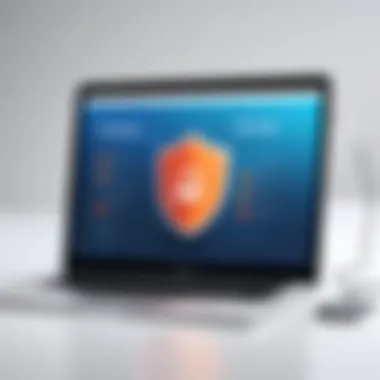Understanding Malwarebytes and Phishing Emails


Intro
In an era where digital communication forms the backbone of both personal and professional interactions, understanding the threats like phishing emails becomes essential. Phishing is not merely an inconvenience; it is an elaborate tactic used by cyber criminals to exploit unsuspecting victims. These email scams can lead to significant data breaches and financial loss. That’s where Malwarebytes plays a critical role in the cyber defense landscape.
Combining advanced detection methodologies with user-friendly interfaces, Malwarebytes helps identify and neutralize these threats. The purpose of this article is to provide IT professionals and tech enthusiasts with an in-depth understanding of both phishing risks and the specific functionalities of Malwarebytes. This exploration will facilitate better email security practices and the effective deployment of Malwarebytes in safeguarding digital assets.
Features Overview
Malwarebytes has carved out a reputation for itself in the field of cybersecurity, primarily due to its rich set of features tailored to combat various threats, including phishing emails.
Key Specifications
- Real-time Protection: This feature continually scans incoming emails and attachments, providing immediate alerts regarding potential phishing threats.
- Web Protection: Malwarebytes blocks harmful websites that could come up during web browsing, an essential barrier against phishing.
- Threat Intelligence: By leveraging a continuously updated database, Malwarebytes can recognize new phishing tactics quickly, helping it defend more effectively.
- User-Friendly Interface: The software is designed with the user in mind, enabling less tech-savvy users to navigate easily while still providing advanced options for experts.
Unique Selling Points
- Multi-layered Detection: Unlike many antivirus solutions that rely on signature-based detection, Malwarebytes utilizes behavior-based techniques among others to find anomalies.
- Quick Scans: The software is optimized for quick scanning, ensuring minimal disruption to workflows and effective identification of threats.
- Cross-Platform Compatibility: Malwarebytes supports various operating systems ensuring that users on different platforms can protect their devices effectively.
"Phishing emails are often the gateway to larger attacks. Understanding them is the first step in cybersecurity awareness."
Performance Analysis
The efficacy of any security software like Malwarebytes is often determined through performance analysis. This encompasses benchmarking results and how it operates in real-world scenarios.
Benchmarking Results
In controlled testing environments, Malwarebytes has consistently shown reliable detection rates against phishing emails. The scores often outperform many competitors in both speed and accuracy, sometimes achieving as high as 99% in detection capability according to third-party evaluations.
Real-world Scenarios
In practical situations, the software has demonstrated its resilience. For instance:
- During an organizational email security review, Malwarebytes successfully identified and blocked numerous phishing attempts that evaded other security measures.
- An IT department saw a significant drop in successful phishing attempts after implementing Malwarebytes, demonstrating its real-world effectiveness.
Through this examination, it becomes evident that understanding both the nature of phishing risks and the mechanisms employed by Malwarebytes is imperative for anyone involved in IT security. As phishing tactics evolve, so must our defenses.
Prelude to Phishing Emails
Phishing emails are a significant threat in today's digital landscape. Understanding this topic is crucial for anyone involved in cybersecurity. Phishing attempts exploit the vulnerabilities of individuals and organizations. These emails are designed to deceive users into revealing sensitive information, such as passwords, credit card numbers, or other personal data. The importance of recognizing phishing as a prevalent tactic cannot be understated.
Phishing can lead to severe consequences for organizations, including financial loss, data breaches, and reputational damage. As phishing evolves, attackers develop new techniques that make identification increasingly difficult. Training and awareness are critical in mitigating these risks. IT professionals must prepare to handle such threats effectively.
Key elements to discuss in this section include:
- Definition of phishing and its implications.
- The historical development of phishing tactics over time and the learning curve of attackers.
- The impact phishing has on various organizations and industries.
By addressing these topics, we equip ourselves with the necessary knowledge to fight against the phishing epidemic. This call to action leads us to examine each aspect of phishing more closely.
Mechanics of a Phishing Attack
The exploration of phishing attacks is crucial in understanding how cyber threats infiltrate organizations. Phishing encompasses a range of deceptive tactics used to lure individuals into revealing sensitive information. Knowledge about the mechanics of these attacks helps bolster defenses against them. Understanding specific techniques allows IT professionals to better design training and security measures, ultimately safeguarding their networks. The awareness of phishing methodologies can minimize the impact on both individuals and organizations, paving the way for more robust cybersecurity protocols.
Common Techniques Used


Phishing attacks utilize several sophisticated approaches. Recognizing these methods can help in their prevention and detection.
Email Spoofing
Email spoofing is a technique where a malicious actor disguises email to appear as though it comes from a legitimate source. This deception is a key contributor to successful phishing attacks. The primary characteristic of email spoofing lies in its ability to manipulate unsuspecting users. Attackers can create emails that mimic trusted entities like banks or official organizations.
This tactic is popular in phishing attacks because it exploits the trust users inherently have in recognized brands, increasing the likelihood of interaction. A unique feature of email spoofing is its simplicity and availability; any user can send an email that appears genuine without needing advanced technical skills. However, the downside is that many email clients have started to implement more sophisticated filtering systems to detect these spoofed mails.
Malicious Links
Malicious links are another widely used technique in phishing schemes. Attackers insert hyperlinks in emails that lead victims to fraudulent websites designed to steal personal information. The key characteristic of malicious links is their ability to redirect users without them realizing it. These links often rely on URL shortening or obfuscation, making them seem harmless or familiar.
This method is highly beneficial for scammers; it allows for the quick execution of an attack without the need for physical interaction with the victim's computer. Nevertheless, it poses challenges for users who may hesitate to click on links due to security prompts. The effectiveness of this tactic relies heavily on users undermining their own instincts.
Attachment Exploits
Attachment exploits are a further technique often used in phishing attacks. These involve sending emails that include infected attachments, such as documents or executable files. The key characteristic of attachment exploits is that they introduce malware directly into the user's system, often leading to unauthorized access or data loss.
This method appeals to attackers due to its high success rate; once a file is downloaded and executed, the attacker can gain control over the target's system. The unique feature of attachment exploits is their reliance on user action—victims must actively decide to open a file, which can often be disguised as important or legitimate. However, this also allows users the opportunity to exercise caution if they recognize warning signs, like unexpected file types or suspicious sender details.
Psychological Manipulation in Phishing
Phishing attacks do not rely solely on technology but also on psychological tactics. These involve exploiting human emotions and instincts. Attackers often use urgency or fear to provoke a quick response from the target. For instance, an email may claim that immediate action is necessary to secure an account, thus reducing the chance for rational thought. Understanding these manipulative tactics is vital for training individuals to recognize and reject phishing attempts.
Real-World Examples of Phishing Scams
Real-world examples provide insight into the varied approaches attackers employ. For instance, an infamous case involved a series of emails that appeared to come from human resources departments, requesting personal information for tax purposes. Many employees fell victim due to the credibility of the source and the urgency embedded in the request.
Another example includes fake messages from services like PayPal, where recipients were directed to cloned websites mimicking the legitimate login page. These accounts highlight the need for constant vigilance and worker education on identifying phishing tactics. By evaluating such cases, organizations can develop better training programs that address specific vulnerabilities inherent in their workforce.
Overview of Malwarebytes
The importance of Malwarebytes in the context of phishing emails cannot be overstated. As a leading player in cybersecurity software, Malwarebytes provides essential tools to combat the persistent threat of phishing attacks. This section will explore various elements that highlight its relevance and efficiency in protecting against these malicious endeavors.
Company History and Development
Malwarebytes was founded in 2004 by Marcin Kleczynski and his team of security experts. Initially focused on malware removal, it has since evolved into a comprehensive security solution. The company's growth reflects its commitment to innovation and user-centric design, adapting to the ever-changing landscape of cyber threats. Over the years, Malwarebytes has been recognized for its effectiveness in detecting and removing various types of malware, thus establishing a strong reputation in the cybersecurity market.
Core Functionalities of Malwarebytes
Malware Detection
Malware detection is a critical functionality of Malwarebytes that safeguards devices from various threats. The software employs heuristics and signature-based detection methods to identify malicious software, making it a popular choice among IT professionals. A key characteristic is its ability to swiftly analyze files and processes, providing real-time insights into potential threats. This unique feature helps ensure early detection, allowing users to take proactive measures against attacks. However, while effective, it may sometimes result in false positives, requiring users to manually confirm the legitimacy of flagged applications.
Real-Time Protection
Real-time protection is another standout feature of Malwarebytes. It continuously monitors system activity to block threats before they can inflict harm. This proactive approach is crucial in a landscape rife with emerging phishing threats. The main advantage of real-time protection is that it offers peace of mind to users, knowing that their systems are under constant surveillance. However, this feature may use additional system resources, which could slow down older devices.
Malware Removal
The malware removal capability of Malwarebytes is what sets it apart from its competitors. Once a threat is detected, the software can remove malicious files and restore the system to its previous state. This functionality is indispensable for users grappling with existing infections. A unique feature of this aspect is the capability to perform a boot-time scan, enabling the identification of malware that may be lurking during regular operating conditions. While highly effective, the thoroughness of the removal process can lead to extended downtime for the user, which could be a disadvantage in urgent situations.
Versions of Malwarebytes Software


Free vs. Premium Versions
Malwarebytes offers both free and premium versions, catering to different user needs. The free version provides basic malware detection and removal tools, suitable for individuals seeking minimal protection. On the other hand, the premium version expands functionality with real-time protection and scheduled scanning capabilities. Adjustability in pricing and features makes this choice popular among diverse user demographics. The unique feature of the premium version is its ability to detect and block ransomware, which adds significant value. However, some users may find the transition to a paid version costly.
Business Solutions
Malwarebytes also caters to business environments with tailored solutions. These solutions offer comprehensive protection to multiple devices within an organization, ensuring a unified approach to cybersecurity. A key characteristic of these business solutions is the centralized management dashboard, allowing IT administrators to oversee security measures across all devices efficiently. This feature is particularly beneficial for organizations that need to maintain high security levels without the complexity of managing individual licenses. Nevertheless, the setup of such systems may require significant initial investment and training for staff.
Malwarebytes and Phishing Protection
Protecting against phishing emails is a necessity for both individuals and organizations. Malwarebytes stands out as a significant player in this defense game. Phishing protection is not just about identifying malicious emails; it's about creating a multi-layered approach that includes detection, blocking, and continual user awareness. Understanding how Malwarebytes approaches these challenges can empower IT professionals and tech enthusiasts in crafting secure environments.
Detection Capabilities
Malwarebytes employs sophisticated detection capabilities that are crucial for identifying phishing attempts. Its advanced algorithms analyze email content, scrutinizing various elements such as sender addresses and subject lines. This proactive scanning helps to filter out potential threats before they reach the inbox. The software uses heuristic analysis to recognize patterns typical of phishing schemes, even if they are not yet documented in signature databases. The integration of machine learning further enhances its ability to adapt to new phishing tactics that emerge over time.
"Effective detection capabilities are a cornerstone of phishing protection and evolving threats require adaptive solutions."
Additionally, Malwarebytes constantly updates its detection engine, ensuring real-time support against the latest phishing attacks. The focus is not merely on marking an email as spam but providing a robust solution that can recognize subtle deceit in emails designed to fool users.
Phishing Website Blocking
The blocking of phishing websites is another essential feature of Malwarebytes. Phishing websites often masquerade as legitimate sites to extract personal information. Malwarebytes employs a comprehensive database of known phishing sites, which gets regularly updated. When a user attempts to access such a site, Malwarebytes acts swiftly to block the connection, protecting users from accidental exposure.
Web protection does not rely solely on pre-existing lists. The software utilizes real-time information and behavior analysis to flag new threats. Any suspicious link, whether embedded in an email or shared on a social platform, is evaluated against ongoing data collection. Users are immediately alerted, significantly reducing the chances of successful phishing attempts.
User Feedback on Phishing Protection
User feedback plays a pivotal role in the development of Malwarebytes' phishing protection strategies. Ratings and reviews from users offer insights into the software's real-world effectiveness. Many users appreciate the ease of use, noting that the program alerts them to risks without overwhelming them with prompts.
Feedback often highlights a specific feature: the user-friendly dashboard. This interface provides clarity on the status of scan results and any potential threats. Users report high satisfaction with the blocking capabilities—many have stated that they avoided threats that would have compromised sensitive information. Yet, some users express a desire for enhanced customization options for scanning frequency, which demonstrates a need for continuous improvement.
In summation, Malwarebytes offers a solid defense against phishing threats through its comprehensive detection capabilities, proactive website blocking, and receptivity to user feedback. For IT professionals navigating increasingly complex phishing landscapes, leveraging such tools can significantly bolster cybersecurity efforts.
Best Practices for Preventing Phishing
Preventing phishing is crucial in today's digital landscape. Phishing attacks have become increasingly sophisticated and prevalent, making it essential for organizations to adopt effective countermeasures. This section highlights strategies that can effectively mitigate the risk of falling victim to phishing scams. By understanding and implementing these best practices, organizations can foster a culture of cybersecurity awareness among employees and enhance their overall email security.
Employee Training and Awareness
Training employees is the foundation of any successful cybersecurity strategy. When employees are aware of the potential threats posed by phishing, they are less likely to become victims. Regular training sessions that cover the latest phishing tactics can significantly reduce risks.
- Educate staff on identifying phishing indicators, such as unusual sender addresses, poor grammar, or urgent calls to action.
- Simulated phishing exercises can provide hands-on experience, allowing employees to navigate common scenarios without any real risk.
- Encourage open communication about suspicious emails. Employees should feel comfortable reporting potential threats without feeling they will be reprimanded.
Employee training creates a defense in depth, where informed employees act as the first line of defense against phishing.
Email Filtering Techniques
Implementing effective email filtering techniques is another essential practice. These tools can catch phishing attempts before they reach the inbox. Organizations should consider the following:
- Use advanced spam filters that leverage machine learning to identify and block fraudulent emails.
- Whitelist and blacklist protocols can ensure that only credible sources are permitted while known malicious sources are banned.
- URL checking features can detect phishing links before users click on them, preventing potential breaches.
These measures reduce the number of phishing emails that require employee vigilance and serve to lessen the attack surface.


Implementing Multi-Factor Authentication
Multi-Factor Authentication (MFA) is an effective deterrent against unauthorized access. Even if an employee inadvertently discloses sensitive information, MFA adds an extra layer of security. Organizations should:
- Require MFA for all accounts, especially those containing sensitive data.
- Educate employees on MFA procedures, ensuring they understand the importance of this step.
- Regularly reassess and update MFA methods to keep up with evolving threats.
By integrating MFA into their authentication process, organizations can significantly reduce the risk of phishing successes.
"Combining employee training with robust filtering and MFA can create a comprehensive strategy against phishing attacks."
Analyzing Phishing Threats
In the realm of cybersecurity, analyzing phishing threats is fundamental. Phishing is an evolving challenge that demands vigilance from IT professionals. The importance lies in recognizing patterns and tactics that attackers use. Understanding these elements can help in building stronger defenses, ensuring that organizations remain safe from potential breaches caused by phishing emails.
Being knowledgeable about phishing threats allows teams to better allocate resources to training and software deployments. Equally important is staying updated on the latest trends in phishing, as attackers are continually developing more sophisticated techniques. This proactive approach can signify the difference between mitigating a risk and suffering a significant breach.
Recognizing Phishing Indicators
To effectively detect phishing attempts, it is crucial to recognize specific indicators of phishing. Some common signs include:
- Poor Grammar and Spelling Errors: Many phishing emails originate from non-native speakers, exhibiting noticeable language flaws.
- Unexpected Requests for Sensitive Information: Legitimate organizations rarely request sensitive information through email.
- Generic Greetings: Phishing emails often use generic salutations like "Dear Customer" instead of personalized names.
- Urgent Calls to Action: Scammers often create a false sense of urgency to lure victims into making hasty decisions.
By training employees to identify these signs, organizations can significantly decrease the chances of falling victim to phishing.
Tools for Analyzing Phishing Attempts
There are various tools available for analyzing phishing attempts, and leveraging these can enhance an organization's defensive strategies. Some popular options include:
- PhishTank: A community-driven platform that collects and analyzes phishing URLs, which can help identify active threats.
- Malwarebytes: Renowned for its malware detection capabilities, it also provides useful features to combat phishing attempts.
- Google Safe Browsing: This tool helps identify unsafe web pages and alerts users before they interact with potential threats.
Using these tools, IT teams can gather data on phishing attempts, enabling a thorough analysis of threats and adjusting security policies accordingly.
Case Studies of Successful Mitigation
Analyzing real-world scenarios sheds light on effective responses to phishing threats. In one instance, a large financial institution suffered a phishing attack that prompted hundreds of employees to disclose sensitive information. However, the organization had implemented a robust security training program.
As soon as the attack was identified, the IT department swiftly activated a multi-factor authentication system. This significantly limited unauthorized access to sensitive data, demonstrating the efficiency of combining training with technological solutions.
Furthermore, another company faced a similar phishing campaign. It drew on its previous experiences to develop a task force focused on analyzing phishing patterns. Their insights helped refine existing defenses and ultimately led to the prevention of future attacks.
Organizations that adapt and learn from past phishing incidents often demonstrate notable resilience against future threats.
Closure
In analyzing the intersection of phishing emails and Malwarebytes, one central theme emerges: the ever-evolving nature of cyber threats. Phishing is not merely a nuisance; it poses significant risks to individuals and organizations. Understanding how to recognize these threats and knowing the tools available to combat them are crucial for maintaining security.
Summarizing Key Points
Throughout this article, we have explored several essential aspects:
- Phishing Tactics: Phishing continues to evolve, utilizing sophisticated techniques to deceive users. Recognizing common signs can help mitigate risks.
- Malwarebytes' Role: The software has proven capabilities in detecting phishing attempts, showcasing the need for effective tools in modern cyber defense strategies.
- Preventive Actions: Training and awareness remain the first line of defense against phishing. Coupling this with technological solutions such as real-time scanning enhances security.
These key points underscore the necessity for continuous education on security practices and the imperative of robust software like Malwarebytes.
Future Outlook on Phishing and Security Solutions
Looking ahead, the landscape of phishing attacks will likely become more complex. Cybercriminals constantly adapt their methods, necessitating ongoing vigilance from organizations. The integration of AI and machine learning in security solutions could play a significant role in predicting and preventing phishing attempts.
In addition, the awareness and training of employees must keep pace with threat evolution. As phishing attacks become more sophisticated, so too must the training that prepares individuals to recognize and thwart these threats.



